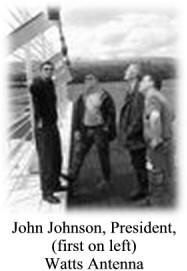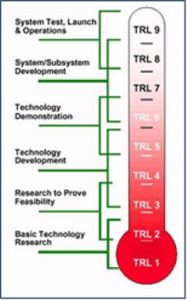Instrument Landing Systems (ILS):
The Competitive Landscape
Wednesday, August 12, 2009— ILS is a technology that, in its essential form, has been around since 1939. For better or worse, ILS is viewed as a legacy or ‘stopgap’ landing solution pending the full roll-out of Global Positioning System (GPS) and its various augmentation systems, WAAS, LAAS. ILS shares this perceived stopgap status with newer, competing technologies such as the Transponder Landing System (TLS) and the Microwave Landing System (MLS). Watts Antenna Company’s MODEL 201 HIGHLY DIRECTIVE LOCALIZER SYSTEM essentially neutralizes the singular advantage of MLS, namely its small RF footprint. In addition, TLS is constrained by its one-plane-per-approach transponder locking technology.
Though niche markets will remain for these legacy technologies, the gap will continue to narrow via successively more sophisticated (GPS) satellite constellations. Currently in development are the GPS-modernization IIF program and its successor, GPS-IIIA.
The inevitable dominance of GPS notwithstanding, the NextGen GPS IIF constellation is presently experiencing significant cost overruns and schedule delays, at last report $780 million and three years, respectively. Though GPS is often touted as an outright replacement of traditional landing systems, the latter represent only a small functionality of GPS.
The potential seriousness of these delays was recently highlighted in an April 2009 GAO report “Global Positioning System: Significant Challenges in Sustaining and Upgrading Widely Used Capabilities”:
The GAO report paints a dire picture. As further illustrated in the chart below, the report points out that, “the estimated long-term probability of maintaining a constellation of at least 24 operational satellites falls below 95 percent during fiscal year 2010 and remains below 95 percent until the end of fiscal year 2014, at times falling to about 80 percent.”


Even with a full complement of satellites, GPS has very real shortcomings; susceptibility to jamming, line-of-sight requirements and solar flaring are three obvious vulnerabilities. Also, though rarely talked about, in the event of a large-scale war it is hard to imagine the U.S. military not controlling GPS accuracy for its own benefit. Paradoxically, by releasing GPS into the public domain for commercial and international use, the strategic-military efficacy of the technology is dramatically curtailed –unless it can be jammed in times of national crisis. Even more ominous, the ubiquity of GPS technology ensures that it can be turned against the US in times of war. Thus in a wartime context, ILS becomes even more critical as a ‘non-compromisable’ national defense asset.” In fairness, it should be noted that Air Force spokesmen by and large dispel the alarmist tone of the GAO study.
The GPS next-gen delay has caused repercussions in yet another legacy system slated for upgrade. Calling it “an antiquated navigation system that is no longer required by the armed forces, the transportation sector or the nation’s security interests”, the Obama administration’s Office of Management and Budget (OMB) defunded the Long Range Navigational System (Loran-C), ostensibly a terrestrially-based GPS back-up system in its Fiscal Year 2010 budget submission. This provoked an outcry in the Loran community prompting Congress to reinstate funding. However the Senate version of the bill provides only $18 million to extend Loran-C operations through January 4, 2010. The decision to drop Loran-C also would effectively cancel the next-generation e-Loran system. Moreover such a cancellation would run counter to the recommendations of the 2008 Federal Radionavigation Plan which recognizes Loran-C and its successor e-Loran “…as a backup to GPS for critical infrastructure applications requiring precise time and frequency.” Interestingly, page 3-9 of the Radionavigational Plan makes reference to “FAA plans of retaining a minimum network of VOR, DME, and ILS facilities to serve as a backup to GPS for the near future…”
Watts Antenna Company’s President Johnson is quick to point out that, when it comes to the critical issue of returning human beings safely to the ground, legacy systems have a certain undeniable appeal. In fact in its nearly seventy years of operation, ILS boasts a perfect safety record. Not one fatality can be attributed to ILS error.
In short, old does not automatically mean bad. Though often cast in a negative light, the term ‘legacy’ can just as easily imply stability, maturity and reliability. Then too, there is the ‘next-gen bias’ that swirls around the federal planning and procurement process. Industry is not above steering government towards lucrative R&D efforts where concrete deliverables loom somewhere in the distant-future. A recent Institute for Defense Analyses report, “Can Profit Policy and Contract Incentives Improve Defense Contract Outcomes?” suggests that R&D efforts typically involve Cost Plus Fixed Fee (CPFF) contracts where performance and contract risk are low. There’s money in blue-sky.
Oddly enough, this R&D bias can foster an environment where workable systems are overlooked for no reason other than that they already exist. This is not to say additional R&D can’t propel ILS further. On the contrary, Watts Antenna’s Johnson hints at some exciting developments on the ILS horizon. Still there can be no doubt that GPS R&D has been the elephant in the laboratory for a number of years. In fact it’s not uncommon to read that ILS development, having reached full maturation in 1973, essentially stopped. No large entities are funding major ILS development efforts. Some are reluctant to fund ILS R&D for fear of alienating the powerful political interests that clearly favor GPS. Johnson views ILS’ R&D deficit with a mixture of excitement and apprehension: “We’re confident cooler heads will prevail. ILS is simply too proven and mature to be discarded out-of-hand. Right now, it’s enduring unfair assault from an odd combination of political correctness and techno-arrogance. In the final analysis, ILS works. That has to be good for something.”
Recent government statements support the recognition that legacy technologies will not be entirely abandoned. DOT’s Positioning, Navigation and Timing (PNT) Research and Innovative Technology Administration, as recently as May 2009, acknowledged that legacy-based system augmentations for GPS, even beyond the signal correcting necessity of a Wide Area Augmentation System (WAAS) will be required. According to Karen van Dyke, Acting Director of DOT’s PNT within the Research and Innovative Technology Administration (RITA), a DOT entity:
“[There is an] awareness within the transportation community of risks associated with use of GPS as a primary means for position determination and precision timing. Due to the reliance of transportation on GPS signals, it is essential that threats be mitigated and alternative back-ups be available, and the system be hardened for critical applications. DOT has determined that sufficient alternative navigation aids currently exist in the event of a loss of GPS based services.”
Perhaps it’s no accident that the ‘demise of ILS’ has been trumpeted in some quarters since as early as 1980. Though the FAA is politically obliged to favor GPS it still purchases ILS systems. In many respects the political dialogue contradicts the operational reality. One can only hope that, in the final analysis, public welfare eclipses party-line. If so, ILS should continue to play some role in the landing system space for the foreseeable future.
Towards a Deployable-Instrument Landing System (D-ILS):
A Status Assessment
Tuesday, August 11, 2009— On July 28-29 2009, Watts Antenna Company visited Hanscom AFB for the purpose of responding to, analyzing and presenting Key Performance Parameters (KPP’s) and Key System Attributes (KSA’s) for a Deployable-Instrument Landing System (D-ILS.) The occasion was formally deemed an “Industry Day.” This means the U.S. Air Force is still soliciting input from industry as to the form, fit and function of the final requirement. A Request for Proposal (RFP) and contract award is anticipated later this year. For the purpose of clarity, definitions of the aforementioned terms are taken from Chairman of the Joint Chiefs of Staff Manual (CJCSM 3170.01C; May 2007) Operation of the Joint Capabilities Integration and Development System:
“KPPs are those attributes or characteristics of a system that are considered critical or essential to the development of an effective military capability…KPPs must be testable to enable feedback from test and evaluation efforts to the requirements process.”
“KSAs are those system attributes considered most critical or essential for an effective military capability but not selected as a KPP. KSAs provide decision makers with an additional level of capability prioritization below the KPP but with senior sponsor leadership control.”
 Once the prioritization of KPP’s/KSA’s is clarified by the military for a given requirement, industry participants assess their available technology offerings with a view to establishing the ‘readiness’ with which they can address the requirement. This methodology is extensively laid out in the Department of Defense’s Technology Readiness Assessment (TRA) Deskbook.
Once the prioritization of KPP’s/KSA’s is clarified by the military for a given requirement, industry participants assess their available technology offerings with a view to establishing the ‘readiness’ with which they can address the requirement. This methodology is extensively laid out in the Department of Defense’s Technology Readiness Assessment (TRA) Deskbook.
The Technology Readiness Assessment (TRA) methodology originated within NASA in the 70’s and was adopted by the Air Force in the 90’s. It also happens to echo a recurrent Government Accountability Office (GAO) theme, that is, the tendency of contractors –in their eagerness to obtain contracts– to mislead the government by bidding prospective technologies as though they were Commercial or Government Off-the-Shelf (COTS/GOTS) solutions. This over-promising exposes the government to needless schedule/cost delays as the contractor scrambles to ‘make good’ on his bid.
The TRA methodology compels the contractor to define, at the RFP stage, the maturity level of his technology in a high-level Work Breakdown Structure (WBS) and by Critical Technology Element (CTE) and Technology Readiness Level (TRL) on a scale of 1-9 –a ‘9’ being the highest level of maturity. The TRL scale encapsulates the entire technology life-cycle from basic research to demonstrability-via-prototype to testability, operability and launchability, etc.
It is important to note that not all deliverables are CTE’s. Indeed there is an eight-question criteria-set whereby a technology-deliverable is deemed to be a CTE, or not. These criteria involve, among other things, the novelty of the requested technology, its operational impact, affordability and the extent of required modifications, etc.
Watts Antenna Company is confident it will demonstrate ‘at-or-near TRL 6 capability’ (that is, Technology Demonstration) at its Cobb County, Georgia August 17-27 exercise. This exercise will involve an ILS rapid-tear-up-tear-down sequence at three separate locations on behalf of the FAA. Antenna subsystem development (towards TRL 8-9) will benefit and proceed from the Cobb County experience. That said, there still exists the need to develop a system fully answerable to the hostile terrains and combat environments delineated in the D-ILS requirement. Watts has extended an invitation to Air Force personnel with a D-ILS interest.
In the meantime, the collaboration between industry and the Air Force continues to shape and prioritize their requirements (via KPP/KSA evolution) as well as to assess the current TRL status of existing ILS technology and its migration path towards a fully deployable configuration.
Watts State-of-the-Art ILS Delivers NextGen Solutions Now
Monday, August 10, 2009— One of the FAA’s Next Generation Air Transportation System’s (NextGen) stated goals is to work in partnership with the aviation industry to identify realizable NextGen capabilities that can be approximated using existing aircraft equipage.
The first Governing Principle outlined in the 2009 NextGen Implementation Plan addresses targeting and leveraging existing airport infrastructure and capabilities in order to expedite the NextGen roadmap. NextGen is an ambitious multi-layered upgrade to the National Airspace System which currently extends through 2025.
Watts Antenna Company believes many NextGen objectives can be captured well in advance of the NextGen 2012-2018 midterm timeframe using “NowGen” ILS technology. Indeed the Watts MODEL 201 HIGHLY DIRECTIVE LOCALIZER SYSTEM with its wide array and small beam-width design has been proven in independent studies to reduce the sensitive area (as defined for example by ICAO, Annex 10) from 450 feet to 300 feet. By reducing the ILS sensitive area to little more than the width of a 747-400 (211 feet) and the separation distance between aircraft, ILS in effect eliminates its encroachment on valuable airport assets and resources, delivering immediate advantages. These advantages include:
decreased separation between arrivals.
departing aircraft allowed greater proximity to runway, decreasing taxi-into-position time.
overall reduced runway occupancy time (ROT).
economic maximization of the airport facility due to radically diminished ILS multi-path concerns.
Despite the significant advances offered by Watts ILS solutions, an industry perception persists that ILS is an antiquated ‘last-gen’ technology. That said, industry appears to be awakening to the fact that Watts, with its innovative approach to critical and sensitive area reduction, has gone back to the future, delivering NextGen now.
By effectively ‘erasing’ (for all practical purposes) the ILS RF on taxiways and aprons, a host of indirect but crucial advantages accrue to other stated NextGen objectives such as:
Increase Flexibility in the Terminal Environment
Reduced Weather Impact
Increase Safety, Security and Environmental Performance
Even more exciting, these advantages can be captured now (as opposed to the projected 2012 roll-out of CAT II/III GBAS.) The opportunity cost of this three-year head-start on NextGen capabilities is huge, particularly given the current economic climate and uncertain break-even horizon for NextGen investment.
For example, in March 2009 testimony before the House Subcommittee on Aviation, the Air Transport Association (ATA) offered broad support for the NextGen initiative while simultaneously expressing reservations about its protracted deployment and the resultant cost-benefit implications. In the words of ATA President and CEO James C. May (and as further shown by the ATA chart shown below): “The plan contemplates significant stakeholder investment, in addition to FAA investment, but no real benefit for many years. Without a timely return on investment, there is little incentive for airlines and other users to invest in new equipment and training. In short, the current FAA plan does not make a strong business case.”

In the present era of constrained capital investment, the airline industry has a financial imperative to capture any and all cost economies available through now-gen technology. At Watts, the question is as simple as it is overlooked: what incremental benefits (beyond curved approaches) will year-2012 GBAS provide that Watts Cat II/III ILS solutions cannot deliver today?
In our view ILS offers what NextGen at this stage can only promise. Watts is making NextGen happen now.
###
Watts Antenna Company, June 23, 2009; News Summary by Amy Johnson
Original Article: Will Obama Kill Navigation Backup System as GPS Threatens to Fail
Popular Mechanics by Joe Pappalardo May 21, 2009
LORAN-C (Long-Range Aids to Navigation) is a series of earth based navigation stations; comprised of antennas, some as tall as 900 feet, and their transmitting stations. All LORAN-C systems are staffed with Coast Guard personnel, and serve as a back-up to the current GPS program. In effort to better back-up the GPS program the LORAN-C stations were upgraded to what is now called eLORAN. These upgrades were made to ensure that eLORAN has a constant transmission of data and that more detailed data can be gathered.
As of the recent 2010 budget cuts by the Obama Administration funding for LORAN-C has been taken away. Peter Orzag, Director of Obama’s Office of Management has stated that ‘long-range, radio-navigation system has been made obsolete by GPS’. Unfortunately this cut was done before the recent report by the Government Accountability Office (GAO).
This report raises concern for the GPS program because of many uncertainties. The total GPS program is three years behind schedule and more than $870 million over budget. There are also concerns that many satellites are approaching their life-expectancy, if not already past it, and there are no functional replacements.
Watts Antenna Company, June 24, 2009; News Summaries by Amy Johnson
Original Article: Galileo: GSA Reorganized, Contract Talks
Inside GNSS, 360 Degrees, May/June 2009
It is at the early stages of discussion that the European GNSS Supervisory Authority (GSA) would transfer from its leading agency to the European Commission (EC) acting as a public-private partnership (PPP). The GSA includes the Galileo system as well as the European Geostationary Navigation Overlay Service (EGNOS).
‘The GSA is to be renamed the GNSS Agency, and the EC will maintain a veto power of its administrative board as well as conducting security audits.’
‘On April 1, ownership of the EGNOS infrastructure was transferred to the EC and the Brussels based company, the European satellite Services Provider (ESSP SaS) has been trusted with operation of the system.
The EC is currently working with a 3.4 Million Euro budget and negotiating with multiple industry members, with the end goal being a ‘fully operational capability (FOC) Galileo system’.
Watts Antenna Company, June 24, 2009; News Summaries by Amy Johnson
Original Article: GAO Warns of Potential GPS Satellite Gap
Inside GNSS, 360 Degrees, May/June 2009
The U.S Government Accountability Office (GAO) has recently published a report suggesting a delay, of production and launch, for two years for the GPS Program. This delay is specifically targeted at the GPS III satellites. The concern is that as satellites get older we will drop below a 24 satellite system. Because there are satellites in orbit that are still functional that was ‘launched more than a decade ago with a design life of 7.5 years.’
This delay will reduce the quality of GPS transmissions and hinder our militaristic abilities and also because of our dependence on GPS Urban navigation diminish the abilities of the nation’s businesses, first responders, and the general public.
It has been expressed that the GPS program is having difficulties communicating its satellites to the ground equipment. In response to this difficulty the ‘U.S. Government plans to invest more than $5.8 Million’ on top of the already over-budget program to advance the GPS Space and ground segments.
Watts Antenna Company, June 19, 2009; News Summary by Amy Johnson
Original Article: GPS Satellite Glitches Fuel Concern on Next Generation
Wall Street Journal, Business Section, June 17, 2009; By Andy Pasztor
The last of the GPS IIF satellites manufactured by Lockheed Martin is experiencing significant technical problems while in orbit. The source of this problem is contributed to the fact that the last satellite was ‘upgraded’ to include the newest addition by Lockheed; the L5 frequency. The L5 frequency was added for use of civilian services, with air-traffic situations in mind. This frequency is rendering the other signals from the satellite extremely inaccurate. Industry officials say this satellite is accurate to about 20 feet where as the others in orbit are accurate two feet.
This is of great concern to the Air Force because the Pentagon insists on 24 completely functional satellites in orbit; and the satellites in orbit are approaching their replacement date without a functional replacement in production. It is Gen. Robert Kehler’s, head of Air Force Space Command, opinion that the life expectancy of the satellites can be extended with by managing the power output.
There may not be a spare in the future but Boeing Co. is developing a satellite to replace those currently in orbit. The complication there lies in the fact that these were developed with the L5 frequency feature. While Boeing and Lockheed are separate companies the complications with Lockheed’s L5 now questions the integrity of Boeing Co.’s L5 project which is already past schedule and vastly over budget.
The Air Force is looking into these implications and is in the process of determining if more testing is needed for the Boeing models before they are launched. It has already been stated by the Air Force that the future tests will cover the ‘receiver equipment to the greatest extent possible’
The Boeing Co. satellites were due to be launched this summer and it is now estimated to be launched as late as early 2010.
Watts Antenna Company, June 19, 2009; News Summary by Amy Johnson
Original Article: 360 Degrees, News from the world of GNSS, SVN49 & L5: Mixed Result
Inside GNSS May/June 2009 Issue
‘Air Force Unable to Declare Latest GPS Satellite as Healthy’
On March 25 2009, a satellite was launched successfully into orbit with the capability of transmitting an L5 frequency. This frequency has been recently developed (at 1176.4 MHz) with the intent to be used for ‘safety-of-life applications’. Beginning on April 10, usable L5 signals were transmitting.
However the same satellite is concurrently sending ‘out of family’ transmissions of the L1 frequency; these frequencies appear to be changing based on the elevation of the satellite at any particular moment.
These changes in frequencies were initially detected on the first day of transmission, April 10, 2009. However, by then it was too late to solve the problem, which the Air Force is contributing to a mechanical difficulty, because the satellite was already in orbit.
These anomalies are contributed to the L5 addition made on this satellite, because the other Block IIR (18 in orbit) built without the L5 are performing fine.
As a result; the GPS program will probably be further delayed. GPS Wing’s Chief Engineer, Col. (Select) David Goldstein stated “We’re in no hurry because of our overpopulated constellation”.
Watts Antenna Company, June 19, 2009; News Summary by Amy Johnson
Original Article: Inside the Government’s Backup Plans for GPS Failure
Popular Mechanics by Joe Pappalardo June 3, 2008
In 2009, the Department of Homeland Security allotted $34.5 million to modify LORAN (Long-Range Aids to Navigation) to a system called eLORAN. This was in effort to backup the future GPS program. The Department Of Homeland Security realized the potential threat if there were to be any sort of disruption of our GPS systems, since they are not only used for person use but, business and military use as well.
eLORAN in its efforts to supplement the GPS program will send out a constant transmission from Earth into space. With its new modifications it will be better equipped to handle more detailed information without disruptions.
Watts Antenna Company, June 19, 2009; News Summary by Amy Johnson
Original Article: GPS Could Fail Next Year, Warns GAO
Information Week by K.C. Jones May 20, 2009
It was recently published in a report by the U.S. Government Accountability Office (GAO) that there is a realistic possibility of failure in the Global Positioning System (GPS). This difficulty could have far reaching implications because the GPS system is used for both civilian and military purposes.
The GAO contributes theses problems on a multitude of variables. A major concern is the fact that the governing organization has a high turn-over rate and therefore there is no lineage in objectives for this program. ‘As of today the current phase of the GPS program has cost more than $870 Million and the launch of the first satellite has been pushed back three years’.
The main concern that the Air Force is currently facing is that as the old generation of satellites approach their expiration date that there are no replacements available and therefore there will be less satellites in orbit than the amount the U.S. Government has deemed necessary.
Other factors that are contributing to the delay are; the fact that the Air Force is having difficulty with communicating satellite to the receiver and other ground based user equipment; and that the U.S. Department of Defense is trying to determine just how much access to our GPS systems should be allowed to the general public and what should be left to military defense.
